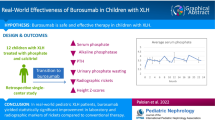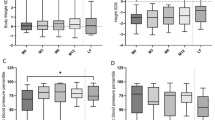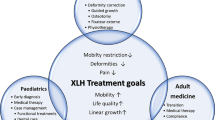Abstract
Purpose of Review
X-Linked hypophosphatemia (XLH) is the most common genetic cause of rickets. This review describes advances in the management of XLH using burosumab which was FDA approved for treating children with XLH in 2018.
Recent Findings
Elevated FGF23 in XLH leads to systemic hypophosphatemia and several musculoskeletal manifestations, including rachitic bone deformities, impaired growth, dental abscesses, insufficiency fractures, osteoarthritis, and enthesopathy, with lifelong consequences for physical function and quality of life. Burosumab treatment has demonstrated clinical improvement of rickets and growth in children, including during a randomized controlled trial compared with conventional therapy. Burosumab also improved pseudofracture healing in adults.
Summary
Burosumab led to greater improvement in rickets and growth than conventional therapy. However, many questions remain regarding the impact of burosumab on several outcomes, including final height, nephrocalcinosis, dental disease, enthesopathy, and surgical interventions.
Similar content being viewed by others
References
Haffner D, Emma F, Eastwood DM, Duplan MB, Bacchetta J, Schnabel D, et al. Clinical practice recommendations for the diagnosis and management of X-linked hypophosphataemia. Nat Rev Nephrol. 2019;15(7):435–55. https://doi.org/10.1038/s41581-019-0152-5.
Hyp Consortium. A gene (PEX) with homologies to endopeptidases is mutated in patients with X-linked hypophosphatemic rickets. The HYP Consortium. Nat Genet. 1995;11(2):130–6. https://doi.org/10.1038/ng1095-130.
Sabbagh Y, Jones AO, Tenenhouse HS. PHEXdb, a locus-specific database for mutations causing X-linked hypophosphatemia. Hum Mutat. 2000;16(1):1–6. https://doi.org/10.1002/1098-1004(200007)16:1<1::AID-HUMU1>3.0.CO;2-J.
Zhang H, Chavez MB, Kolli TN, Tan MH, Fong H, Chu EY, et al. Dentoalveolar defects in the Hyp mouse model of X-linked hypophosphatemia. J Dent Res. 2020;99(4):419–28. https://doi.org/10.1177/0022034520901719.
Liu S, Guo R, Simpson LG, Xiao Z-S, Burnham CE, Quarles LD. Regulation of fibroblastic growth factor 23 expression but not degradation by PHEX. J Biol Chem. 2003;278(39):37419–26.
Urakawa I, Yamazaki Y, Shimada T, Iijima K, Hasegawa H, Okawa K, et al. Klotho converts canonical FGF receptor into a specific receptor for FGF23. Nature. 2006;444(7120):770–4. https://doi.org/10.1038/nature05315.
Shimada T, Hasegawa H, Yamazaki Y, Muto T, Hino R, Takeuchi Y, et al. FGF-23 is a potent regulator of vitamin D metabolism and phosphate homeostasis. J Bone Miner Res. 2004;19(3):429–35. https://doi.org/10.1359/JBMR.0301264.
Larsson T, Marsell R, Schipani E, Ohlsson C, Ljunggren O, Tenenhouse HS, et al. Transgenic mice expressing fibroblast growth factor 23 under the control of the alpha1(I) collagen promoter exhibit growth retardation, osteomalacia, and disturbed phosphate homeostasis. Endocrinology. 2004;145(7):3087–94. https://doi.org/10.1210/en.2003-1768.
Boukpessi T, Hoac B, Coyac BR, Leger T, Garcia C, Wicart P, et al. Osteopontin and the dento-osseous pathobiology of X-linked hypophosphatemia. Bone. 2017;95:151–61. https://doi.org/10.1016/j.bone.2016.11.019.
Demay MB, Sabbagh Y, Carpenter TO. Calcium and vitamin D: what is known about the effects on growing bone. Pediatrics. 2007;119(Suppl 2(Suppl 2)):S141–4. https://doi.org/10.1542/peds.2006-2023F.
Tiosano D, Hochberg Z. Hypophosphatemia: the common denominator of all rickets. J Bone Miner Metab. 2009;27(4):392–401. https://doi.org/10.1007/s00774-009-0079-1.
Imel EA. Congenital conditions of hypophosphatemia in children. Calcif Tissue Int. 2020;108:74–90. https://doi.org/10.1007/s00223-020-00692-5.
Zivicnjak M, Schnabel D, Billing H, Staude H, Filler G, Querfeld U, et al. Age-related stature and linear body segments in children with X-linked hypophosphatemic rickets. Pediatr Nephrol. 2011;26(2):223–31. https://doi.org/10.1007/s00467-010-1705-9.
Thacher TD, Pettifor JM, Tebben PJ, Creo AL, Skrinar A, Mao M, et al. Rickets severity predicts clinical outcomes in children with X-linked hypophosphatemia: utility of the radiographic Rickets Severity Score. Bone. 2019;122:76–81. https://doi.org/10.1016/j.bone.2019.02.010.
Insogna KL, Briot K, Imel EA, Kamenicky P, Ruppe MD, Portale AA, et al. A randomized, double-blind, placebo-controlled, phase 3 trial evaluating the efficacy of burosumab, an anti-FGF23 antibody, in adults with X-linked hypophosphatemia: week 24 primary analysis. J Bone Miner Res. 2018;33(8):1383–93. https://doi.org/10.1002/jbmr.3475.
Chesher D, Oddy M, Darbar U, Sayal P, Casey A, Ryan A, et al. Outcome of adult patients with X-linked hypophosphatemia caused by PHEX gene mutations. J Inherit Metab Dis. 2018;41:865–76. https://doi.org/10.1007/s10545-018-0147-6.
Liang G, Katz LD, Insogna KL, Carpenter TOE, Macica CM. Survey of the enthesopathy of X-linked hypophosphatemia and its characterization in Hyp mice. Calcif Tissue Int. 2009;85(3):235–46. https://doi.org/10.1007/s00223-009-9270-6.
Polisson RP, Martinez S, Khoury M, Harrell RM, Lyles KW, Friedman N, et al. Calcification of entheses associated with X-linked hypophosphatemic osteomalacia. N Engl J Med. 1985;313(1):1–6. https://doi.org/10.1056/NEJM198507043130101.
Steele A, Gonzalez R, Garbalosa JC, Steigbigel K, Grgurich T, Parisi EJ, et al. Osteoarthritis, osteophytes, and enthesophytes affect biomechanical function in adults with X-linked hypophosphatemia. J Clin Endocrinol Metab. 2020;105(4):dgaa064. https://doi.org/10.1210/clinem/dgaa064.
Skrinar A, Dvorak-Ewell M, Evins A, Macica C, Linglart A, Imel EA, et al. The lifelong impact of X-linked hypophosphatemia: results from a burden of disease survey. J Endocr Soc. 2019;3(7):1321–34. https://doi.org/10.1210/js.2018-00365.
Carpenter TO, Imel EA, Holm IA, Jan de Beur SM, Insogna KL. A clinician's guide to X-linked hypophosphatemia. J Bone Miner Res. 2011;26(7):1381–8. https://doi.org/10.1002/jbmr.340.
Imel EA, Glorieux FH, Whyte MP, Munns CF, Ward LM, Nilsson O, et al. Burosumab versus conventional therapy in children with X-linked hypophosphataemia: a randomised, active-controlled, open-label, phase 3 trial. Lancet. 2019;393(10189):2416–27. https://doi.org/10.1016/S0140-6736(19)30654-3.
Makitie O, Doria A, Kooh SW, Cole WG, Daneman A, Sochett E. Early treatment improves growth and biochemical and radiographic outcome in X-linked hypophosphatemic rickets. J Clin Endocrinol Metab. 2003;88(8):3591–7. https://doi.org/10.1210/jc.2003-030036.
Imel EA, DiMeglio LA, Hui SL, Carpenter TO, Econs MJ. Treatment of X-linked hypophosphatemia with calcitriol and phosphate increases circulating fibroblast growth factor 23 concentrations. J Clin Endocrinol Metab. 2010;95(4):1846–50. https://doi.org/10.1210/jc.2009-1671.
Carpenter TO, Insogna KL, Zhang JH, Ellis B, Nieman S, Simpson C, et al. Circulating levels of soluble klotho and FGF23 in X-linked hypophosphatemia: circadian variance, effects of treatment, and relationship to parathyroid status. J Clin Endocrinol Metab. 2010;95(11):E352–7. https://doi.org/10.1210/jc.2010-0589.
DeLacey S, Liu Z, Broyles A, El-Azab SA, Guandique CF, James BC, et al. Hyperparathyroidism and parathyroidectomy in X-linked hypophosphatemia patients. Bone. 2019;127:386–92. https://doi.org/10.1016/j.bone.2019.06.025.
Aono Y, Hasegawa H, Yamazaki Y, Shimada T, Fujita T, Yamashita T, et al. Anti-FGF-23 neutralizing antibodies ameliorate muscle weakness and decreased spontaneous movement of Hyp mice. J Bone Miner Res. 2011;26(4):803–10. https://doi.org/10.1002/jbmr.275.
Aono Y, Yamazaki Y, Yasutake J, Kawata T, Hasegawa H, Urakawa I, et al. Therapeutic effects of anti-FGF23 antibodies in hypophosphatemic rickets/osteomalacia. J Bone Miner Res. 2009;24(11):1879–88. https://doi.org/10.1359/jbmr.090509.
Portale AA, Carpenter TO, Brandi ML, Briot K, Cheong HI, Cohen-Solal M, et al. Continued beneficial effects of burosumab in adults with X-linked hypophosphatemia: results from a 24-week treatment continuation period after a 24-week double-blind placebo-controlled period. Calcif Tissue Int. 2019;105(3):271–84. https://doi.org/10.1007/s00223-019-00568-3.
FDA. CRYSVITA® (burosumab-twza) injection, for subcutaneous use; Initial U.S. Approval: 2018; revised 9/2019, revised 6/2020. In: FDA, editor. https://www.accessdata.fda.gov.
Imel EA, Zhang X, Ruppe MD, Weber TJ, Klausner MA, Ito T, et al. Prolonged correction of serum phosphorus in adults with X-linked hypophosphatemia using monthly doses of KRN23. J Clin Endocrinol Metab. 2015;100(7):2565–73. https://doi.org/10.1210/jc.2015-1551.
Carpenter TO, Imel EA, Ruppe MD, Weber TJ, Klausner MA, Wooddell MM, et al. Randomized trial of the anti-FGF23 antibody KRN23 in X-linked hypophosphatemia. J Clin Invest. 2014;124(4):1587–97. https://doi.org/10.1172/JCI72829.
Thacher TD, Fischer PR, Pettifor JM, Lawson JO, Manaster BJ, Reading JC. Radiographic scoring method for the assessment of the severity of nutritional rickets. J Trop Pediatr. 2000;46(3):132–9.
Whyte MP, Fujita KP, Moseley S, Thompson DD, McAlister WH. Validation of a novel scoring system for changes in skeletal manifestations of hypophosphatasia in newborns, infants, and children: the radiographic global impression of change scale. J Bone Miner Res. 2018;33(5):868–74. https://doi.org/10.1002/jbmr.3377.
Carpenter TO, Whyte MP, Imel EA, Boot AM, Hogler W, Linglart A, et al. Burosumab therapy in children with X-linked hypophosphatemia. N Engl J Med. 2018;378(21):1987–98. https://doi.org/10.1056/NEJMoa1714641.
Whyte MP, Carpenter TO, Gottesman GS, Mao M, Skrinar A, San Martin J, et al. Efficacy and safety of burosumab in children aged 1-4 years with X-linked hypophosphataemia: a multicentre, open-label, phase 2 trial. Lancet Diabetes Endocrinol. 2019;7(3):189–99. https://doi.org/10.1016/S2213-8587(18)30338-3.
Imel EA, Glorieux FH, Whyte MP, Portale AA, Munns CF, Nilsson O et al. In pediatric X-linked hypophosphatemia (XLH), burosumab improved clinical outcomes versus higher and lower doses of oral phosphate and/or active vitamin D. American Society for Bone and Mineral Research Annual Meeting Online (Conference held virtually due to COVID19). 2020:Abstract P-326.
Insogna KL, Rauch F, Kamenicky P, Ito N, Kubota T, Nakamura A, et al. Burosumab improved histomorphometric measures of osteomalacia in adults with X-linked hypophosphatemia: a phase 3, single-arm, international trial. J Bone Miner Res. 2019;34(12):2183–91. https://doi.org/10.1002/jbmr.3843.
Liu E, Lira dos Santos E, Chavez M, Kolli T, Foster B. 1,25-Dihydroxyvitamin D and anti-FGF23 blocking antibody treatments improve dentoalveolar tissues in the Hyp mouse model of X-linked hypophosphatemia. American Society for Bone and Mineral Research Annual Meeting Online (Conference held virtually due to COVID19). 2020:Abstract P-288.
Pharmacoeconomic review report: burosumab (Crysvita): Kyowa Kirin Limited: Indication: For the treatment of X-linked hypophosphatemia in adult and pediatric patients one year of age and older [Internet]. Ottawa (ON): Canadian Agency for Drugs and Technologies in Health; Appendix 1, Cost Comparison. Available from: https://www.ncbi.nlm.nih.gov/books/NBK565319.
Gordon RJ, Levine MA. Burosumab treatment of children with X-linked hypophosphataemic rickets. Lancet. 2019;393(10189):2364–6. https://doi.org/10.1016/S0140-6736(19)31054-2.
Collins M. Burosumab: at long last, an effective treatment for FGF23-associated hypophosphatemia. J Bone Miner Res. 2018;33(8):1381–2. https://doi.org/10.1002/jbmr.3544.
Funding
This manuscript was supported in part by the National Institutes of Health through NIAMS grant P30AR072581.
Author information
Authors and Affiliations
Corresponding author
Ethics declarations
Conflict of Interest
EAI has received research funding and fees for consultation from Ultragenyx Pharmaceuticals.
Human and Animal Rights and Informed Consent
This article does not contain any studies with human or animal subjects performed by the author.
Additional information
Publisher’s Note
Springer Nature remains neutral with regard to jurisdictional claims in published maps and institutional affiliations.
This article is part of the Topical Collection on Pediatrics
Rights and permissions
About this article
Cite this article
Imel, E.A. Burosumab for Pediatric X-Linked Hypophosphatemia. Curr Osteoporos Rep 19, 271–277 (2021). https://doi.org/10.1007/s11914-021-00669-9
Accepted:
Published:
Issue Date:
DOI: https://doi.org/10.1007/s11914-021-00669-9




